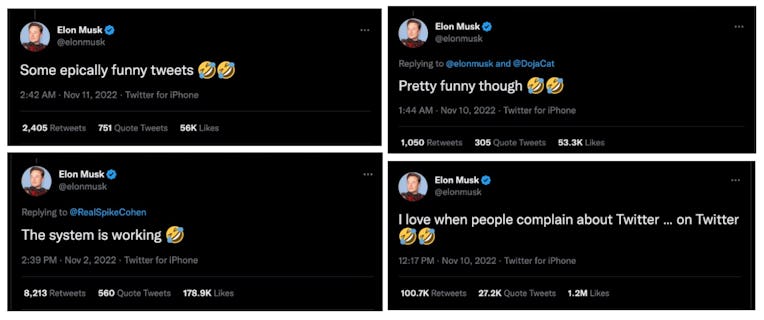Why So 🤣 Elon?
He's not mad, data shows he's actually cry laughing more than usual

There hasn’t been a universal language since at least the Tower of Babel. Esperanto was a bust. Interlingua was a joke funded by a Vanderbilt. Don’t even talk to me about “Ido,” as I don’t know what any of its words mean and neither does anyone else. But few dialects have come closer to global comprehension than emojis. They’re the hieroglyphics of the internet age, the wingdings of the 21st century, only they mean stuff, like “I’m a cloud” (😶🌫️) or “I’m a passive aggressive coward” (🙃). Because of this universal legibility, most people with access to the computer can interpret this easily:
🤣
This is obvious. This is clear as day. This means you are dealing with a highly aggrieved maniac who thinks the height of humor is an epic bacon meme or a joke about pronouns. This is the pictorial equivalent of buying a ticket to see Ricky Gervais and dutifully clapping like a trained seal. Nobody who has sent this emoji has actually been laughing while they hit send, merely staring blankly at a screen, idly wondering if they should send a third follow-up text to their ex.
It also happens to be one of Elon Musk’s most-used emojis on Twitter. Indeed, between Aug. 1 and Nov. 11, he tweeted it out 98 times. For contrast, the total number of times he tweeted other emojis in that same period was just 69. To quote Elon, nice. But since Musk’s quixotic attempt to buy Twitter became increasingly likely to succeed, despite his best efforts, he seemed to have been relying on his friend 🤣 more than ever. We’re not the only ones to notice this.
But has he actually been cry-face emojing more than usual? Or is it just an illusion born from the fact that he seems to have torpedoed his new purchase almost immediately after taking the helm? He definitely wants to laugh; that’s why, once the purchase went through, he declared comedy was “finally legal.” At the same time, he evidently cannot take a joke; that’s why he started requiring users to double-label said jokes to avoid confusion or making him feel small. Hence: 🤣.
A meticulous and officially verified review of Musk’s tweets since August show that he has indeed been cry-laughing at a greater frequency. Consider this chart:
You can see a fairly steep increase in October, before a descent in November. But to be fair, we’re only 11 days into the month. He still has 19 days to up his total. So what does it look like if we shrink the period down to two weeks? It looks like this:
Now that’s a slope. But we’re still seeing a decline in November. Could that be a side-effect of the fact that Oct. 16-31 is technically 16 days, and Nov. 1-11 is still just 11? Let’s get a closer look:
Oct 21-31
Nov 1-11
This may look like mostly random figures with no clear trend line that I entered into a free online graph generator, and perhaps you’d be right. But it’s interesting that Musk seems to be dropping the 🤣 multiple times per day more frequently in the November chart, and then not using it at all. His highs seem higher, his lows seem lower — a vacillation that, in some sense, captures the true spirit of the symbol.